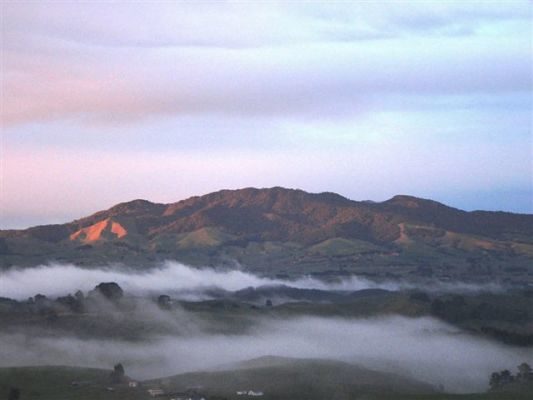The kiore appeared and the moa disappeared in pre-European times, but no-one can argue that the majority of Aotearoa/New Zealand’s predator and other pest introductions, habitat loss, extinctions and near-extinctions have happened in the last 150-200 years since pakeha settlers arrived. Recently published research by Matthew Harms looks at the Maori perspective in a community-based conservation project and the role that indigenous Maori knowledge played in that project.
Harms’ study focuses on the Maungatautari Ecological Island Trust and project, located about 26km south-east of Hamilton. This multi-stakeholder project involved local Maori with an ancestral connection to the mountain, adjoining landowner-farmers, the volunteers who launched and helped lead the project, local and regional council representatives and the Department of Conservation. Beginning officially in 2002, the biodiversity conservation project aimed to restore approximately 3400 Ha of forest ecosystem, with a predator-exclusion fence allowing threatened native species to be reintroduced to the forest. The intention was to develop Maungatautari as “a compelling ecotourism site and globally significant biodiversity conservation reserve”.

Harms writes: “Maori stakeholders there as Mana Whenua (local Maori tribes or subtribes with ancestral connections to and dominion over certain lands and resources) of Maungatautari, have had to make special and calculated efforts to voice their concerns and cultural needs, and get indigenous knowledge, in the form of cultural protocols and concepts, infused into project practices and procedures. Their efforts have at times met with resistance and suspicion.
“Tension and standoffs in the project and community have come about as a consequence of conditioned views and attitudes expressed by some in the community and stakeholder groups in reaction to Mana Whenua increasing their role and the presence of their knowledge and practices in the project and their concurrent effort to reacquire the mountain and other redress by means of a Waitangi Treaty claim settlement. Nevertheless, they have succeeded in many instances big and small to have their cultural ways and knowledge included in the project and repositioned themselves to take a more direct role in relation to Trust decisions and management of the project.”

One example Harms gives of inclusion of cultural knowledge and ways in the project related to cultural harvesting and food safety.
“Maungatautari is unique in the region because it boasts the widest array of medicinal plants and the potential to also have the widest and most robust array of traditional foods. It also is the origin of many streams in the area, which flow into the nation’s largest river, the Waikato…”
Once the mountain’s forest was fully fenced, aerial brodifacoum poison bait drops were made to clear it of invasive predator and pest mammal species. Cats, rats, stoats and possums were eradicated, but mice remained in a few isolated pockets and were now free from introduced predators with little competition for resources. Mouse numbers increased and further aerial poison drops were discussed.
“However, Mana Whenua stressed their rights and desires to continue gathering and using plants like the kawakawa shrub leaves, supplejack (pirita) vine or the native watercress for medicine and food. They voiced concern over the possible uptake of the blood thinner poison into the ecosystem’s animals and the plants they customarily use. Local scientists were consulted and concurred with their concern. Adjoining farmers with pastoral animals and streams that come down through their pastures supported their stance and scientific caution as well. The Trust and project management decided as a result to conduct no further aerial drops. Rather, a shift was made to try and eradicate the last major pest of mice manually, with only small, targeted poison applications thereafter.”

Another example of Mana Whenua input and assertion of rights and desires was the question of whether kereru could be harvested once numbers of the bird increased. The kereru’s size and ease of capture has traditionally meant that it was a staple protein/food source for Maori. For many Maori tribes eating kereru also had another significance: “consumption of the bird near a person’s death was believed to help convey that person’s wairua (soul or spirit)”.
Harms reports: “In the case of Maungatautari, of those I interviewed and discussed the topic with, Maori participants indicated that eating kereru for their tribe had in the past largely been done for tangihanga (funerals and rites for the dead) and special events. They were, however, divided on the issue of whether or not kereru should ever be harvested in the future.
“They all agreed that an unofficial rahui (a moratorium of use of a resource or area associated with tapu) by all intents and purposes had been in place from the beginning of the project. A lifting of the tapu of the mountain had occurred permitting the project fence to be installed and conservation work there, but no official rahui had been set up. As a result, some felt that once the kereru population numbers were strong again, cultural harvesting of the bird could resume under kaitiakitanga (subtribe guardianship of resources) oversight. Others opined that harvest of them should never return to Maungatautari as it was destined to be a Noah’s ark for the country’s threatened species, that it needed to remain an example of conservation and Kentucky Fried Chicken just down the road would suffice. Regardless of their personal stance, they all indicated that they would abide by any future decision on the matter made collectively by Mana Whenua subtribes associated with the project.”
The full research article is published in Global Bioethics and is freely available:

